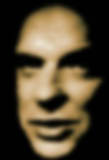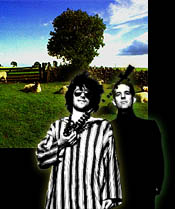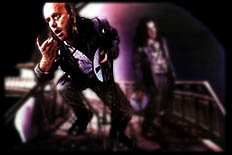|
Ambient Music, Beginnings and Implications by Chris Melchior Notes on Ambient Music by Lloyd Barde Ambient Industrial by Peter Werner But is it MUZAK???? by Bobby DeVito What Is Ambient Music? by Malcolm Humes Isolationism discussion from the Ambient Music Mailing List New Age and Space Music discussion from rec.music.newage Industrial Principles by Jon Savage, as published by V/Search Sleepy Music: results of a 2003 survey of the Ambient Music mailing list Recommended Listening from a survey of the Ambient Music list in 1999 Recommended Listening from surveys of the Ambient Music list in 1994-96 Classic Ambient Recordings: results of a 2001 survey of the Ambient Music mailing list |
 |
It is January 18, 1975. A rock musician is in the hospital, heavily medicated, recuperating after being struck by a taxi as he crossed a street on a rainy day. A friend has brought him a record of harp music to listen to. The man puts the album on. The music plays, but the stereo isn't working properly. The volume is barely above the threshold of hearing, one speaker is silent and the other is pointing away from him. The man is too weak to get up again to correct the situation.
![[ photo copyright Jill Greenberg; used with permission ]](images/eno_sitting.jpg)
"I drifted into this kind of fitful sleep, a mixture of pain-killers and tiredness. And I started hearing this record as if I'd never heard music before.
"It was a really beautiful experience, I got the feeling of icebergs, you know? I would just occasionally hear the loudest parts of the music, get a little flurry of notes coming out above the sound of the rain - and then it'd drift away again..."
photo © Jill Greenberg
An idea strikes. Taking a cue from 1900s composer Erik Satie --who would become agitated if audiences paid too much attention to his performances that were intended for passive listening-- the delirious man now knows what direction his next musical projects will take.
The musician, Brian Peter George St. John le Baptiste de la Salle Eno, begins a study of what he calls Ambient Music: music intended to be as easily ignorable as it is demanding. A minimal form of music based on timbre, texture and deliberate, somewhat randomly shifting structures. Sonic wallpaper. Aural furniture. Eno is not the first to explore these concepts, and he is not the first to call the final product Ambient Music. He does, however, manage to change the world for some people -- people like Alex Paterson, a former roadie and A&R man who gets caught up in the UK acid house dance craze of the late 1980s.
Paterson's DJ gig at a London club begins inconspicously as an experiment in helping exhausted dancers "chill out" in an empty room upstairs from the main floor. He seamlessly melds relaxing music that is compatible with the entranced audience's mindset. Eno's Ambient series and Steve Hillage's Rainbow Dome Musick are always in the playlist. The beats that waft through the floor from the club below are welcome -- they enhance the hypnotic effect. Ambient House is born.
sleeve © Designers Republic![[ Orb sleeve copyright Designers Republic; not used with permission but I hope they won't mind ]](images/orb_sleeve.gif)  |
| The KLF in 1991 |
1989.
Alex Paterson teams with Jimmy Cauty of novelty Scottish rap act The JAMS.
The pair become The Orb, spawning an underground sensation with their innovative debut,
"A Huge Ever Growing Pulsating Brain That Rules From The Centre Of The
Ultraworld." After nearly finishing an album together the unlikely duo split within
a year, just as the movement is gaining momentum. Cauty deletes Paterson's bits from
the album and the resulting self-titled Space enjoys unanimous acclaim among the handful of
critics who manage to find a copy. Paterson starts a new Orb and goes on to sell a million albums.
Cauty remains with fellow JAMs partner Bill Drummond, selling a million
of their own under the moniker KLF.
By 1992, "ambient" comes to mean everything from samples of ocean waves, whale songs, and humming motors to busy, beat-laden dance music that is only marginally spacier and mellower than what's being played in the nightclubs.
Future Sound of London, 1992![[ photo by Adrian Green ] ...next time keep your shirt on...](images/fsol92.jpg) photo © Adrian Green |
In 1995 the genre is at its peak, now encompassing contemporary industrialists, New Age yuppies, and space rock virtuosos as members rather than just influences. Kids looking for electronic Valium buy as many old Tangerine Dream albums as they do new Future Sound of London albums. And one teenager's album of his own Selected Ambient Noodlings leads to a collaboration with Phillip Glass.
"Could I have imagined, all those years ago, as I hid from the fuming testosterone-addled rock critics of the day, that this little word, so derided then, would be so ubiquitous now?"
Brian Eno, January 1995
 The Orb in 1997 |
Ambient continues to be a catch-all at the end of the century, although
as a genre it has become hopelessly fragmented, its relevance measured not
in its growth as an art form, but rather in the sheer volume of ambient-ish
recordings in the music shops. The artists aren't disturbed. They
know where they've been; They're concentrating on where they're going.
They can call it Ambient when they get there.
--Mike Brown, May 1997
If you want to learn more about ambient music, you should a. expose yourself to as much of it as possible, and b. pay attention to the discussions on the ambient music mailing list